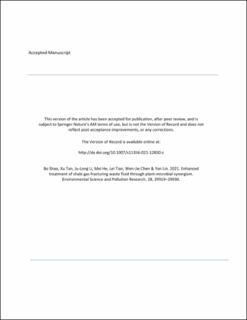| dc.contributor.author | Shao, Bo | |
| dc.contributor.author | Tan, Xu | |
| dc.contributor.author | Li, Ju-Long | |
| dc.contributor.author | He, Mei | |
| dc.contributor.author | Tian, Lei | |
| dc.contributor.author | Chen, Wen-Jie | |
| dc.contributor.author | Lin, Yan | |
| dc.date.accessioned | 2022-02-01T12:18:03Z | |
| dc.date.available | 2022-02-01T12:18:03Z | |
| dc.date.created | 2022-01-23T19:29:06Z | |
| dc.date.issued | 2021 | |
| dc.identifier.citation | Environmental science and pollution research international. 2021, 28 (23), 29919-29930. | en_US |
| dc.identifier.issn | 0944-1344 | |
| dc.identifier.uri | https://hdl.handle.net/11250/2976263 | |
| dc.description | Embargo until February 12, 2022 | en_US |
| dc.description.abstract | Cost-efficient and environmentally friendly treatment of hydraulic fracturing effluents is of great significance for the sustainable development of shale gas exploration. We investigated the synergistic effects of plant-microbial treatment of shale gas fracturing waste fluid. The results showed that illumination wavelength and temperature are direct drivers for microbial treatment effects of CODCr and BOD5, while exhibit little effects on nitrogen compounds, TDS, EC, and SS removals as well as microbial species and composition. Plant-microbial synergism could significantly enhance the removal of pollutants compared with removal efficiency without plant enhancement. Additionally, the relative abundance and structure of microorganisms in the hydraulic fracturing effluents greatly varied with the illumination wavelength and temperature under plant-microbial synergism. 201.24 g water dropwort and 435 mg/L activated sludge with illumination of 450–495 nm (blue) at 25 °C was proved as the best treatment condition for shale gas fracturing waste fluid samples, which showed the highest removal efficiency of pollutants and the lowest algal toxicity in treated hydraulic fracturing effluents. The microbial community composition (36.73% Flavobacteriia, 25.01% Gammaproteobacteria, 18.55% Bacteroidia, 9.3% Alphaproteobacteria, 4.1% Cytophagia, and 2.83% Clostridia) was also significantly different from other treatments. The results provide a potential technical solution for improved treatment of shale gas hydraulic fracturing effluents. | en_US |
| dc.language.iso | eng | en_US |
| dc.publisher | Springer | en_US |
| dc.title | Enhanced treatment of shale gas fracturing waste fluid through plant-microbial synergism | en_US |
| dc.type | Peer reviewed | en_US |
| dc.type | Journal article | en_US |
| dc.description.version | acceptedVersion | en_US |
| dc.source.pagenumber | 29919-29930 | en_US |
| dc.source.volume | 28 | en_US |
| dc.source.journal | Environmental science and pollution research international | en_US |
| dc.source.issue | 23 | en_US |
| dc.identifier.doi | 10.1007/s11356-021-12830-z | |
| dc.identifier.cristin | 1988133 | |
| cristin.ispublished | true | |
| cristin.fulltext | original | |
| cristin.qualitycode | 1 | |
